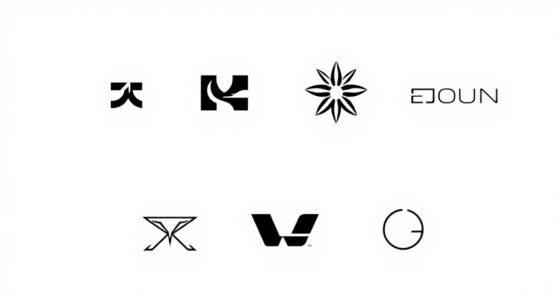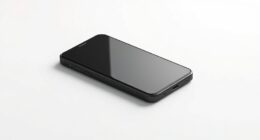Minimalist packaging design captures attention by focusing on what truly matters. You'll find that stripping away excess elements not only enhances the product's appeal but also aligns with a growing demand for authenticity. This approach is more than just aesthetics; it reflects a deeper connection with consumers. Curious about how to implement these principles in your own brand? Let's explore the key elements that define this elegant simplicity.
Key Takeaways
- Minimalist packaging emphasizes simplicity through clean lines, ample negative space, and a limited color palette to enhance product visibility and authenticity.
- Sustainable materials, such as recycled and biodegradable options, align with eco-friendly principles and appeal to environmentally conscious consumers.
- The unboxing experience is designed to be meaningful and engaging, reflecting a commitment to quality and transparency while reducing clutter.
- Successful brands like Apple and Glossier utilize minimalist design to reinforce brand identity and convey elegance through straightforward presentations.
- Minimalist packaging reduces production costs and waste, promoting efficiency and sustainability in manufacturing while resonating with modern consumer preferences.
The Essence of Minimalism
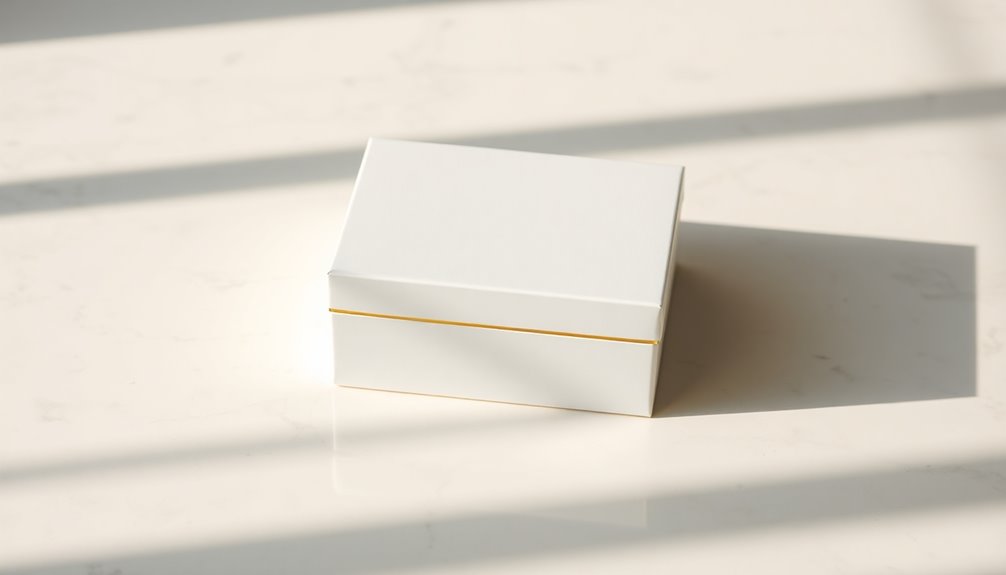
When you think about minimalist packaging design, it's all about stripping away the unnecessary to reveal the product's true essence. This approach emphasizes simplicity, utilizing clean lines and ample negative space to create visual appeal.
By focusing on a limited color palette, minimalist packaging enhances consumer understanding and fosters a sense of transparency and authenticity. It also aligns with eco-friendly practices, often incorporating sustainable materials that reflect contemporary consumer preferences. Additionally, this design philosophy can evoke astrological charm that resonates with consumers seeking authenticity in their purchases.
Functionality remains a priority, ensuring that the packaging not only protects the product but also embodies elegance. As you explore minimalist design, you'll find it resonates deeply with environmentally-conscious audiences, merging aesthetics with purpose to create a lasting impact.
Benefits of Minimalist Packaging
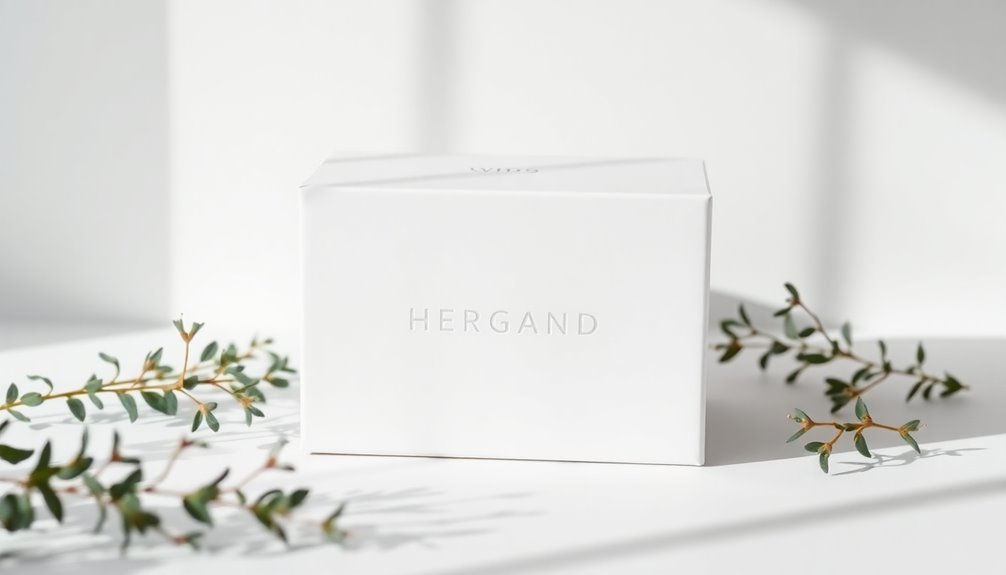
Embracing minimalist packaging offers a range of benefits that can greatly impact both businesses and consumers. Here are some key advantages:
Embracing minimalist packaging benefits both businesses and consumers, enhancing brand appeal and fostering positive relationships.
- Cost Savings: Minimalist packaging reduces production costs by using fewer materials, saving you money in manufacturing and shipping.
- Sustainability: By emphasizing eco-friendly materials, you align with consumer demand for sustainability, lowering your carbon footprint.
- Product Visibility: The streamlined design enhances product visibility on crowded shelves, making it easier for consumers to recognize and choose your products.
- Improved Unboxing Experience: Clutter reduction in packaging leads to a more meaningful unboxing experience, allowing consumers to engage deeply with your brand image.
Additionally, minimalist packaging can contribute to reductions in energy costs for manufacturers, aligning with the broader movement towards sustainable practices.
These benefits of minimalist packaging can remarkably enhance your brand's appeal and contribute to a positive consumer relationship.
Key Design Elements
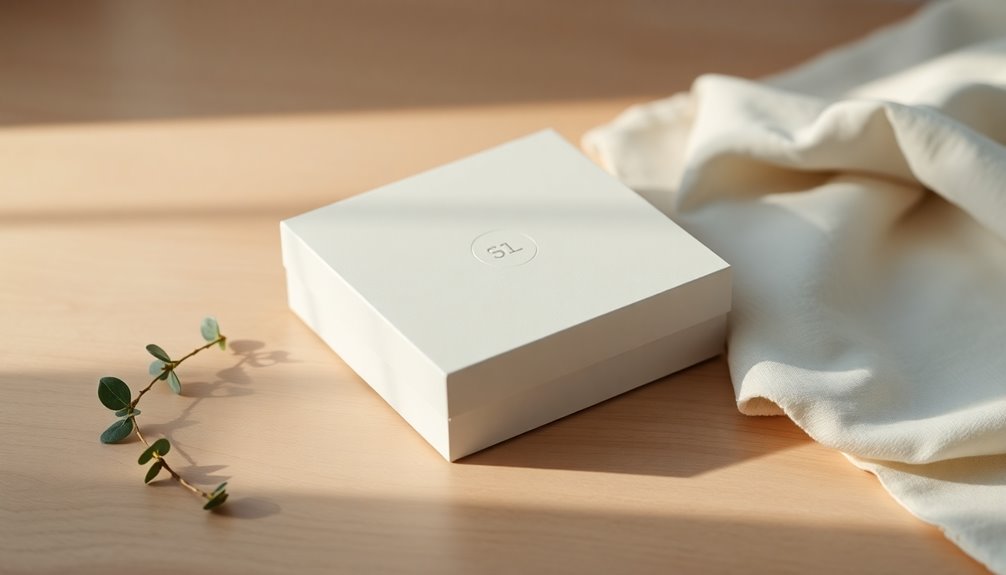
Minimalist packaging design thrives on simplicity, focusing on key elements that elevate both aesthetics and functionality. A limited color palette, often featuring neutral tones or a single dominant color, creates a sophisticated visual appeal.
Negative space plays an essential role, reducing clutter and enhancing product visibility on shelves. Clean and legible typography, typically sans-serif, guarantees readability while keeping the design streamlined.
Texture adds depth, using materials like raised edges or subtle patterns to intrigue without overwhelming. Strategic logo placement strikes a balance between visibility and subtlety, reinforcing brand identity without compromising simplicity and elegance.
These elements work together to create a user experience that's not only visually appealing but also memorable, making minimalist packaging a powerful design choice. Additionally, content relevance and authority are crucial in ensuring that minimalist designs resonate with target audiences and enhance brand perception.
Real-World Examples of Success
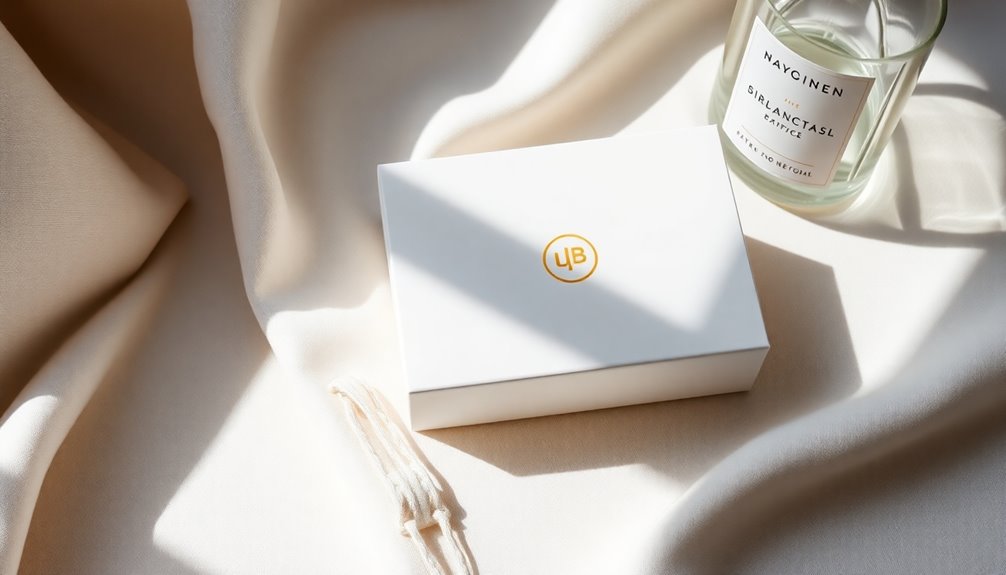
You can see how minimalist packaging shines through in iconic brands like Apple and Glossier, where effective visual communication plays a key role.
By prioritizing sustainable material choices, these brands not only enhance their aesthetic but also connect with consumers who value authenticity. Additionally, the use of sustainable fabrics in their packaging reflects a growing trend towards eco-friendly practices in the fashion industry.
Let's explore how these strategies lead to successful branding and customer loyalty.
Iconic Brand Inspirations
While many brands struggle to stand out in a crowded market, several have found success by adopting minimalist packaging that speaks volumes through simplicity.
Here are four iconic examples of how minimalist packaging reflects brand values:
- Apple – Their clean lines and neutral palette enhance simplicity and clarity, focusing on user experience.
- Glossier – The pastel-colored packaging embodies authenticity, connecting with consumers through straightforward beauty.
- AQUA – Their sleek bottle design emphasizes purity and quality, effectively communicating brand values without clutter.
- MUJI – This brand's unbranded, environmentally friendly packaging highlights functionality, appealing to consumers' demand for no-frills options.
These examples show how minimalist packaging not only elevates product visibility but also aligns with growing consumer demand for authenticity and sustainability. Additionally, brands that embrace diversification strategies can strengthen their market position by resonating with various consumer preferences.
Effective Visual Communication
Effective visual communication is essential for brands looking to connect with their audience. Brands like Apple and Glossier demonstrate how minimalist packaging design can effectively convey a sense of identity and values.
Apple's clean and uncluttered packaging emphasizes simplicity and innovation, while Glossier's pastel colors and minimal text resonate with consumers who value beauty and clarity.
AQUA's sleek bottles highlight freshness and hydration by using fewer materials, enhancing product visibility.
MUJI takes this further with straightforward, unbranded designs that promote transparency and functionality.
These examples show that simplistic design not only creates a unique unboxing experience but also strengthens emotional connections, making it easier for consumers to engage with the product and recognize the brand. Furthermore, minimalist design principles can also draw inspiration from Balinese interior design characteristics, which emphasize harmony and connection with nature.
Sustainable Material Choices
As brands increasingly prioritize sustainability, many are making impactful choices in their packaging materials that resonate with eco-conscious consumers.
Here are some real-world examples of success:
- Coca-Cola uses 100% recycled aluminum for their minimalist cans, showcasing their commitment to sustainable materials.
- Uncommon Goods opts for biodegradable packaging, effectively reducing waste while appealing to environmentally conscious shoppers.
- Lush embraces recycled paper and reusable containers, promoting sustainable practices with minimal design.
- Reformation employs organic cotton and recycled polyester in their packaging, reinforcing their dedication to reducing environmental impact.
Additionally, the tea industry is witnessing a shift towards sustainable production practices, as companies adopt eco-friendly packaging options that align with consumer preferences for responsible sourcing.
These brands illustrate how integrating sustainable materials into packaging solutions not only enhances their identity but also meets the growing demand for responsible consumption.
Implementing Minimalism in Your Brand
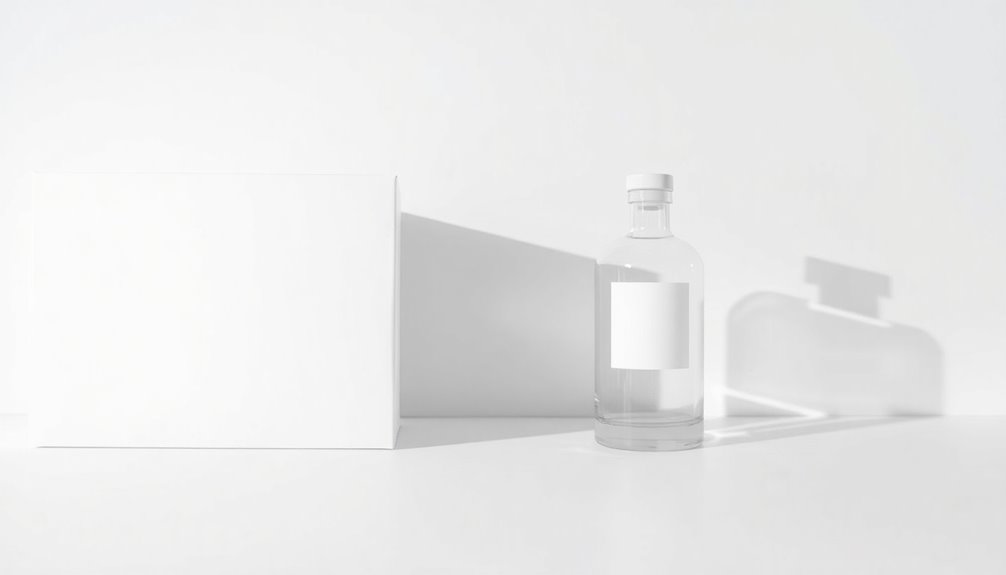
To successfully implement minimalism in your brand, start by honing in on the essential elements that truly represent your identity. Identify a limited color palette and select essential colors that resonate with your brand's values.
When designing minimalist packaging, choose high-quality materials, opting for sustainable packaging like recyclable or biodegradable options to appeal to eco-conscious consumers.
Enhance unboxing experiences by ensuring your packaging reflects your commitment to simplicity and quality. Focus on straightforward presentations that communicate transparency and authenticity, reassuring customers of your brand's integrity. Additionally, consider integrating smart home technology into your branding strategy to connect with modern consumers seeking convenience and innovation.
Tips for Creating Minimalist Packaging
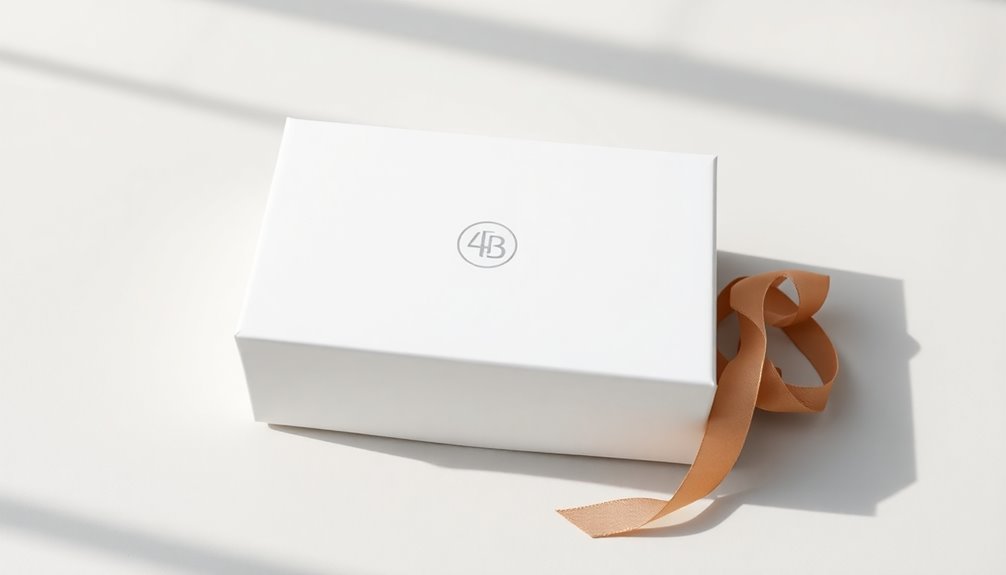
Creating minimalist packaging involves thoughtful choices that enhance your brand's identity while appealing to consumers. Here are some tips to contemplate:
- Use a limited color palette: Stick to neutral or monochromatic tones to emphasize product clarity and maintain a sophisticated look.
- Opt for high-quality materials: Choose recycled paper or biodegradable plastics to align with eco-friendly principles and enhance perceived value.
- Incorporate clean typography: Ascertain the text is legible and complements the minimalist aesthetic to communicate essential information effectively.
- Utilize negative space: This reduces visual clutter, draws attention to the product, and enhances the overall unboxing experience while focusing on functionality.
- Incorporate natural elements: This promotes tranquility and aligns with calming decor principles that enhance any product's presentation.
The Environmental Impact of Minimalism
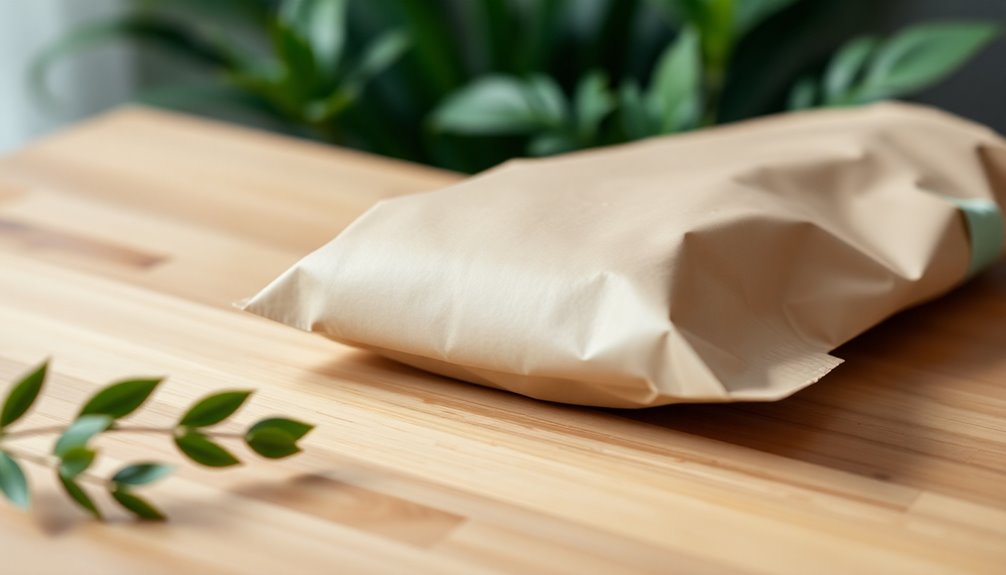
When you embrace minimalist packaging, you greatly reduce material consumption, which directly cuts down on waste. This approach not only lowers your carbon footprint but also opens up enhanced recycling opportunities. Additionally, adopting energy-efficient systems can further minimize environmental impact by reducing overall energy consumption.
Reduced Material Consumption
Minimalist packaging design greatly reduces material consumption, which directly impacts environmental sustainability. By using fewer materials, brands can considerably lower their environmental impact.
Here are some benefits of this approach:
- Up to 40% reduction in material consumption means less waste.
- Utilizing recyclable and biodegradable materials helps minimize landfill contributions.
- Streamlined manufacturing leads to decreasing production costs by about 20%.
- Lightweight packaging can cut packaging waste by 50%, addressing consumer demand for sustainability.
This shift not only reduces the carbon footprint but also promotes a circular economy.
Embracing minimalist packaging is a smart choice for brands that care about both the planet and their bottom line.
Lower Carbon Footprint
The adoption of minimalist packaging design not only reduces material consumption but also plays a crucial role in lowering carbon footprints. By utilizing lightweight materials and eco-friendly options like biodegradable plastics, you can greatly reduce production waste and shipping costs. For instance, cutting packaging weight by just 1 ounce can save up to 10% in shipping costs. Brands embracing this approach enhance their environmental reputation and attract eco-conscious consumers, with 66% willing to pay more for sustainable products. Here's a snapshot of the impact:
| Aspect | Traditional Packaging | Minimalist Packaging |
|---|---|---|
| Material Usage | High | Low |
| Production Waste | Up to 30% more | Up to 30% less |
| Shipping Costs | Higher | Lower |
| Eco-Friendly Options | Limited | Abundant |
Enhanced Recycling Opportunities
Adopting minimalist packaging design greatly enhances recycling opportunities by streamlining materials and processes.
By using fewer materials, you not only reduce waste but also simplify sorting at recycling facilities.
Here's how minimalist packaging makes a difference:
- Prioritizes eco-friendly materials like recycled paper and biodegradable plastics.
- Decreases the reliance on single-use plastics, promoting sustainable alternatives.
- Features clean lines and limited colors, improving product identification in recycling streams.
- Encourages consumer participation in recycling efforts through simplicity and clarity.
These elements collectively boost recycling rates and improve material recovery, paving the way for a greener future.
Embracing minimalist packaging means you're not only making a stylish choice but also contributing to environmental sustainability.
The Future of Minimalist Packaging Design
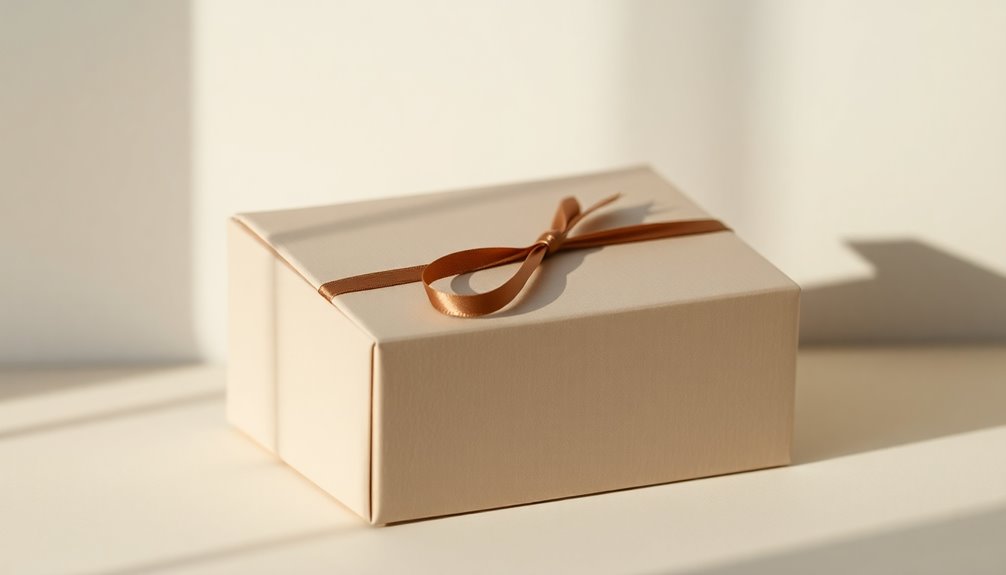
As consumer demand for sustainability grows, brands are increasingly shifting towards minimalist packaging designs that reduce environmental impact. You can expect to see a rise in eco-friendly materials, including biodegradable options, enhancing both aesthetics and functionality. This trend not only boosts product visibility on crowded shelves but also aligns with the desire for transparent branding. Advanced printing techniques and smart packaging solutions will create interactivity, engaging consumers more effectively.
| Trend | Benefits | Future Outlook |
|---|---|---|
| Minimalist Design | Reduces waste | Enhances brand recognition |
| Eco-friendly Materials | Supports sustainability | Increases consumer trust |
| Advanced Printing | Promotes interactivity | Engages consumers visually |
Frequently Asked Questions
How Does Minimalist Packaging Affect Shipping Costs?
When you consider minimalist packaging, you'll find it often reduces shipping costs.
With less material used, the overall weight decreases, leading to lower shipping fees. You also benefit from smaller package dimensions, allowing for more efficient stacking and transportation.
This means you can ship more products at once, cutting costs even further. Plus, fewer materials can streamline your supply chain and reduce waste, making your operations more eco-friendly and cost-effective.
Can Minimalist Packaging Be Used for All Product Types?
You might wonder if minimalist packaging works for all product types. While it's versatile, not every product benefits from this approach.
Fragile items may need additional cushioning, while luxury goods often require more elaborate presentation.
However, for many everyday products, minimalist packaging can enhance appeal and reduce costs.
It's essential to assess the product's nature and target audience to determine if minimalist design truly suits your needs.
What Materials Are Best for Minimalist Packaging?
When choosing materials for minimalist packaging, you'll want to focus on sustainability and simplicity.
Biodegradable options like paper, cardboard, or plant-based plastics work well, as they reduce environmental impact. You might also consider glass or aluminum for their recyclability and clean aesthetic.
Avoid excessive embellishments; instead, opt for clean lines and neutral colors. This approach not only enhances the product's appeal but also aligns with the minimalist ethos, creating a cohesive brand image.
How Do Consumers Perceive Minimalist Packaging Compared to Traditional Designs?
You'll find that consumers often view minimalist packaging as modern and sophisticated, appreciating its clean lines and simplicity.
It creates a sense of transparency and trust, making products feel more premium. In contrast, traditional designs may seem cluttered and overwhelming, which can detract from the product's appeal.
Are There Any Legal Considerations for Minimalist Packaging Design?
When it comes to minimalist packaging design, think of it as a delicate dance.
You've got to be aware of legal considerations like labeling requirements, trademark protections, and environmental regulations. Your design should communicate clearly without misleading consumers.
It's essential to guarantee that all necessary information is included, while still maintaining that elegant simplicity.
Conclusion
In a world cluttered with chaos, minimalist packaging stands out as a symbol of sophistication and sustainability. By embracing elegance in simplicity, you not only enhance your brand's identity but also foster a deeper connection with eco-conscious consumers. As you initiate your design journey, remember: clarity creates curiosity, and less truly is more. Immerse yourself in the delightful depths of minimalist packaging, and watch your products shine with style and purpose.



